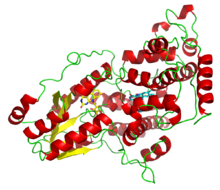Photolyase
| FAD binding domain of DNA photolyase | |||||||||
|---|---|---|---|---|---|---|---|---|---|

A deazaflavin photolyase from Anacystis nidulans, illustrating the two light-harvesting cofactors: FADH− (yellow) and 8-HDF (cyan).
|
|||||||||
| Identifiers | |||||||||
| Symbol | FAD_binding_7 | ||||||||
| Pfam | PF03441 | ||||||||
| InterPro | IPR005101 | ||||||||
| PROSITE | PDOC00331 | ||||||||
| SCOP | 1qnf | ||||||||
| SUPERFAMILY | 1qnf | ||||||||
|
|||||||||
| Available protein structures: | |
|---|---|
| Pfam | structures |
| PDB | RCSB PDB; PDBe; PDBj |
| PDBsum | structure summary |
Photolyases (EC 4.1.99.3) are DNA repair enzymes that repair damage caused by exposure to ultraviolet light. This enzyme requires visible light, preferentially from the violet/blue end of the spectrum, and the mechanism known as photoreactivation.
Photolyase is a phylogenetically old enzyme which is present and functional in many species, from the bacteria to the fungi to plants and to the animals. Photolyase is particularly important in repairing UV induced damage in plants. The photolyase mechanism is no longer working in humans and other placental mammals who instead rely on the less efficient nucleotide excision repair mechanism.
Photolyases bind complementary DNA strands and break certain types of pyrimidine dimers that arise when a pair of thymine or cytosine bases on the same strand of DNA become covalently linked. The bond length of this dimerization is shorter than the bond length of normal B-DNA structure which produces an incorrect template for replication and transcription. The more common covalent linkage involves the formation of a cyclobutane bridge. Photolyases have a high affinity for these lesions and reversibly bind and convert them back to the original bases.
Photolyases are flavoproteins and contain two light-harvesting cofactors. All photolyases contain the two-electron-reduced FADH−; they are divided into two main classes based on the second cofactor, which may be either the pterin methenyltetrahydrofolate (MTHF) in folate photolyases or the deazaflavin 8-hydroxy-7,8-didemethyl-5-deazariboflavin (8-HDF) in deazaflavin photolyases. Although only FAD is required for catalytic activity, the second cofactor significantly accelerates reaction rate in low-light conditions. The enzyme acts by electron transfer in which the reduced flavin FADH− is activated by light energy and acts as an electron donor to break the pyrimidine dimer.
...
Wikipedia
